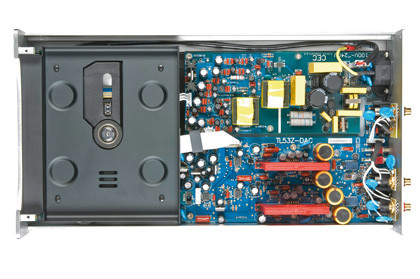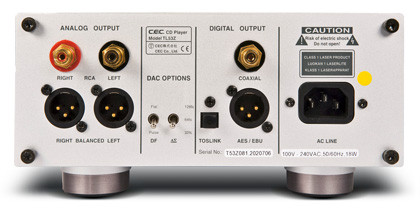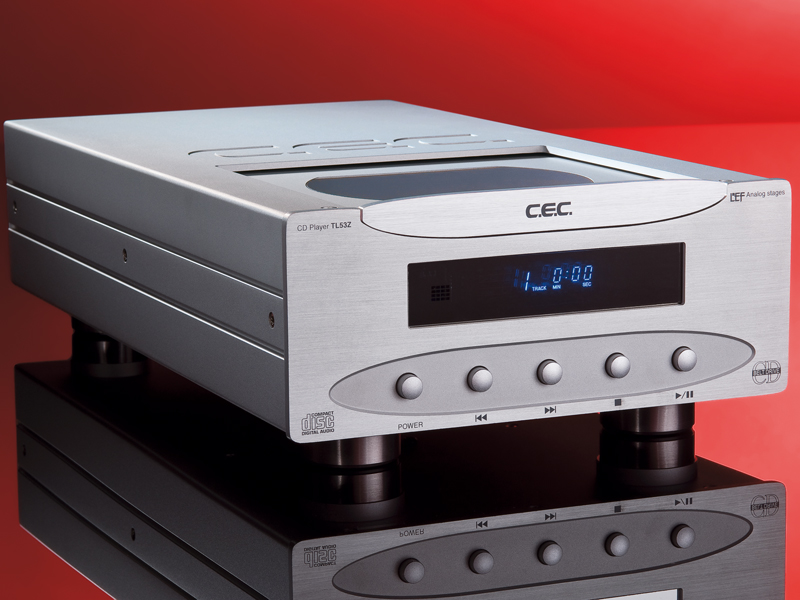TechRadar Verdict
A very well thought out alternative to the more mainstream choices. Capable of stunning results in a suitable system
Pros
- +
Superb build
- +
Flexibility
- +
Lively and unforced sound
Cons
- -
No digital input
- -
Slight lack of drive
Why you can trust TechRadar
C.E.C's newest CD player, the TL 53 Z, features a drive mechanism that's pretty unique. Lift the lid and you'll discover that your spinning discs are fired up via a belt-drive system.
This is a very unusual innovation, in that this kind of technology is usually reserved for turntables. What's more, this belt-drive approach not only brings the humble CD player into the 21st century, it also ups the ante for the overwhelming majority of players, both past and present, which are mechanically driven with the motor connected directly to the spindle.
The brainchild of a Japanese company who has been manufacturing audio-related components for over fifty years, including the mighty TL0X transport, the TL 53 Z is also one of the quietest CD players that we've ever heard at any price point and will, therefore, certainly be high on the list for anyone sensitive to mechanical noise.
Mind you, belt technology is not without considerable engineering challenges. While a turntable is expected to spin at a constant 33, 45 or 78rpm, a CD drive varies in speed depending on the section of the disc being read and the rotational speed is very much higher – between 200 and 500rpm.
To impart the required stability, the TL53Z uses a heavy, metal puck that sits on top of the CD to give a degree of mass to the spinning assembly and impart a degree of control. C.E.C claims that the reason it goes to this considerable effort is to create a mechanism that is resistant to jitter and extremely quiet in operation.
Close attention
Downstream of this unique mechanism, the player becomes a little more conventional, but still rather different to most other CD competitors.
For starters, it uses a pair of Burr-Brown DAC chips in a dual-mono configuration. These then feed their signal into C.E.C's proprietary Current Injection circuit, that creates output voltage without a feedback loop.
Unusually, C.E.C allows the end user to select between three sampling rates of 32, 64 and 128fs and two digital filters called pulse and flat respectively. This is done via a pair of switches on the rear panel of the unit which does make comparative listening between settings more difficult. But by the same token it is nice to be given the opportunity to choose.

Considerable attention has been given to power, with separate power supplies for the transport and DAC and extensive regulation to other sections. Perhaps the only omission for the TL 53 Z is the lack of digital input to gain access to that rather well thought out DAC stage, but the fact that C.E.C produce a DAC in the 53 range would suggest that they believe these two products should exist separately.
Heavy metal
Even judged against other pieces of Japanese mid-market equipment, the C.E.C is extremely well built and feels immensely solid. Perhaps, the only feature that feels anything less than in keeping with the product is the mirrored display, which is slightly reminiscent of a cheap DVD player and did not seem to make the information any easier to read in sunlight.
Access to the belt-drive mechanism is via a sliding door on the top panel that moves with a smooth and precise feel. The disc will spin-up to read the TOC on the door being fully closed with the puck in place.
The TL 53 Z is an unusual shape, being little more than 200mm wide but nearly 500mm deep. This means that partnered with one of the matching 53 series amplifiers, it will take up a single (deep) shelf which is useful if space is tight. The weight of 10 kilograms should give some indication of how solid the C.E.C is.
A special mention must go to the remote control. C.E.C apparently has no time for slim plastic units and have coupled the TL 53 Z with a large handset, constructed almost entirely out of metal. As well as being extremely imposing (and, therefore, hard to misplace), the large size of the remote makes for well-spaced and easy to find buttons. Controls for the matching amplifier also allow for a degree of system management.
The result of all this is that even though the TL53Z is not short of competition, it still feels a genuinely different proposition to other offerings at the price. Due to the decreasing number of suppliers of CD mechanisms, players from smaller manufacturers can feel like an exercise in tweaking performance from the same parts bin of bits.
With its unique mechanism and innovative output stage, as well as the excellent build quality, the C.E.C manages to convey a genuine sense of value even at the relatively lofty price point.
Belt it out
In use, perhaps the most important aspect of the TL 53 Z is that none of the unusual technology inside the unit makes its presence felt in such a way for you to sit up and say "that's definitely down to the belt drive" or similar. This is important, as the intention of the technology is to provide a more natural sound and for the unit to have a distinctive sonic signature as a result of it would be counter-productive.
Instead, from the moment that the C.E.C starts playing, the impression is of an extremely well-sorted and largely viceless digital source. Tonality is excellent giving voices, instruments and percussion a genuine sense of realism. The sense of position and space around instruments is also extremely realistic and does not seem to be fazed by placing a soloist on stage or an entire orchestra.
The quietness of the mechanism and this excellent presentational ability allows you to concentrate totally on the music.
Striking a balance
The C.E.C produces an eloquent and room-filling sound with a neat sense of timing and rhythm. In comparison to some of the key competition, the TL 53 Z is not the most ballistic of players. It will reproduce a spirited bass line with accuracy and finesse, but will not impart the sort of toe-tapping confidence that many listeners will be seeking.
By the same token, low notes are tuneful and start and stop with commendable accuracy, but it is fair to say that some other players can dig a little deeper and harder. Although this is often at the expense of the detail and finesse that the C.E.C brings to recordings.
Ultimately, there is little wrong with the performance of the TL 53 Z that attentive system matching will not overcome and doing so is well worth the effort.
The C.E.C offers the option of unbalanced RCA outputs and balanced XLR's. Adjusted for the difference in output between the two connections, the differences are slight, but the XLR outputs are our preferred option, as they offer a greater sense of depth and space to recordings and bring slightly more weight to the low-end performance.

This is not to say that the TL 53 Z is anything other than extremely talented when connected by normal phono connections and should not be discounted because the rest of the system it is being connected to lacks XLR inputs.
Digital sounds like analogue
The TL 53 Z is a genuinely likable product. With the addition of the much-flagged belt-drive technology, it successfully uses some unusual criteria to create a lively and, above all, very un-digital sound. At the same time, the excellent build quality and the addition of the adjustable sampling and filters means that it feels like it will last a very long time and adapt to system changes.
Some may crave a little more bite and drive from their CD player, but in a system with no shortage of this already, the wonderful tonal accuracy and excellent sense of space will be welcome additions.
Follow TechRadar Reviews on Twitter: http://twitter.com/techradarreview

Ed Selley is a freelance writer who has been playing around with audio equipment – be it selling, supporting, marketing, installing or writing about it – for over 20 years. He worked with a variety of manufacturers before moving into reviewing over a decade ago and now writes about every category of equipment he can get his hands on. He owns more record players than any one human being strictly needs and an obsessively alphabetised record collection to use on it.
